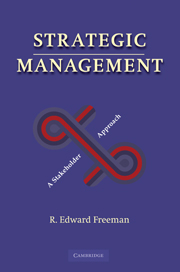Book contents
- Frontmatter
- PREFACE TO THE 2010 REISSUE
- Preface
- Contents
- Part I THE STAKEHOLDER APPROACH
- One “Managing in Turbulent Times”
- Two The Stakeholder Concept and Strategie Management
- Three Stakeholder Management: Framework and Philosophy
- Part II STRATEGIC MANAGEMENT PROCESSES
- Part III IMPLICATIONS FOR THEORY AND PRACTICE
- Bibliography
- Index
Three - Stakeholder Management: Framework and Philosophy
Published online by Cambridge University Press: 05 February 2015
- Frontmatter
- PREFACE TO THE 2010 REISSUE
- Preface
- Contents
- Part I THE STAKEHOLDER APPROACH
- One “Managing in Turbulent Times”
- Two The Stakeholder Concept and Strategie Management
- Three Stakeholder Management: Framework and Philosophy
- Part II STRATEGIC MANAGEMENT PROCESSES
- Part III IMPLICATIONS FOR THEORY AND PRACTICE
- Bibliography
- Index
Summary
INTRODUCTION
Organizations have stakeholders. That is, there are groups and individuals who can affect, or are affected by, the achievement of an organization's mission. I have shown that if business organizations are to be successful in the current and future environment then executives must take multiple stakeholder groups into account. The purpose of this chapter is to discuss how the stakeholder management framework can be used to better understand and manage both internal and external change, and how the management philosophy which accompanies this framework fits into our more customary way of thinking about organizations.
THE STAKEHOLDER FRAMEWORK
The literature discussed in chapter Two yields a broad range of definitions of the stakeholder concept. From the Standpoint of Strategic management, or the achievement of organizational purpose, we need an inclusive definition. We must not leave out any group or individual who can affect or is affected by organizational purpose, because that group may prevent our accomplishments. Theoretically, therefore, “stakeholder” must be able to capture a broad range of groups and individuals, even though when we put the concept to practical tests we must be willing to ignore certain groups who will have little or no impact on the corporation at this point in time. Such a broad notion of “stakeholders” will include a number of groups who may not be “legitimate” in the sense that they will have vastly different values and agendas for action from our own.
- Type
- Chapter
- Information
- Strategic ManagementA Stakeholder Approach, pp. 52 - 82Publisher: Cambridge University PressPrint publication year: 2010
- 6
- Cited by



